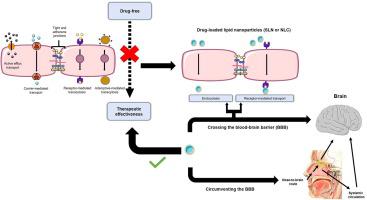Advanced Drug Delivery Reviews ( IF 15.2 ) Pub Date : 2022-08-12 , DOI: 10.1016/j.addr.2022.114485 A C Correia 1 , A R Monteiro 2 , R Silva 2 , J N Moreira 3 , J M Sousa Lobo 1 , A C Silva 4

|
The main limitation to the success of central nervous system (CNS) therapies lies in the difficulty for drugs to cross the blood–brain barrier (BBB) and reach the brain. Regarding its structure and enzymatic complexity, crossing the BBB is a challenge, although several alternatives have been identified. For instance, the use of drugs encapsulated in lipid nanoparticles has been described as one of the most efficient approaches to bypass the BBB, as they allow the passage of drugs through this barrier, improving brain bioavailability. In particular, solid lipid nanoparticles (SLN) and nanostructured lipid carriers (NLC) have been a focus of research related to drug delivery to the brain. These systems provide protection of lipophilic drugs, improved delivery and bioavailability, having a major impact on treatments outcomes. In addition, the use of lipid nanoparticles administered via routes that transport drugs directly into the brain seems a promising solution to avoid the difficulties in crossing the BBB. For instance, the nose-to-brain route has gained considerable interest, as it has shown efficacy in 3D human nasal models and in animal models.
This review addresses the state of the art on the use of lipid nanoparticles to modify the pharmacokinetics of drugs employed in the management of neurological disorders. A description of the structural components of the BBB, the role of the neurovascular unit and limitations for drugs to entry into the CNS is first addressed, along with the developments to increase drug delivery to the brain, with a special focus on lipid nanoparticles. In addition, the obstacle of BBB complexity in the creation of new effective drugs for the treatment of the most prevalent neurological disorders is also addressed. Finally, the proposed strategies for lipid nanoparticles to reach the CNS, crossing or circumventing the BBB, are described. Although promising results have been reported, especially with the nose-to-brain route, they are still ongoing to assess its real efficacy in vivo in the management of neurological disorders.
中文翻译:

脂质纳米颗粒改变中枢神经系统靶向药物药代动力学的策略:穿越或绕过血脑屏障 (BBB) 以管理神经系统疾病
中枢神经系统 (CNS) 治疗成功的主要限制在于药物难以穿过血脑屏障 (BBB) 并到达大脑。关于其结构和酶的复杂性,跨越 BBB 是一个挑战,尽管已经确定了几种替代方案。例如,使用包裹在脂质纳米颗粒中的药物被描述为绕过 BBB 的最有效方法之一,因为它们允许药物通过该屏障,从而提高大脑的生物利用度。特别是,固体脂质纳米颗粒 (SLN) 和纳米结构脂质载体 (NLC) 一直是与大脑药物输送相关的研究重点。这些系统提供对亲脂性药物的保护、改善的递送和生物利用度,对治疗结果产生重大影响。此外,使用通过将药物直接输送到大脑的途径给药的脂质纳米颗粒似乎是一种有希望的解决方案,可以避免穿过 BBB 的困难。例如,鼻子到大脑的路线引起了相当大的兴趣,因为它在 3D 人鼻模型和动物模型中显示出有效性。
这篇综述讨论了使用脂质纳米粒子来改变用于治疗神经系统疾病的药物的药代动力学的最新技术。首先描述了 BBB 的结构成分、神经血管单元的作用和药物进入中枢神经系统的限制,以及增加药物向大脑输送的发展,特别关注脂质纳米颗粒。此外,还解决了 BBB 复杂性在开发用于治疗最普遍的神经系统疾病的新有效药物方面的障碍。最后,描述了脂质纳米颗粒到达中枢神经系统、穿越或绕过血脑屏障的建议策略。尽管已经报道了有希望的结果,特别是在鼻子到大脑的路线上,在体内治疗神经系统疾病。











































 京公网安备 11010802027423号
京公网安备 11010802027423号